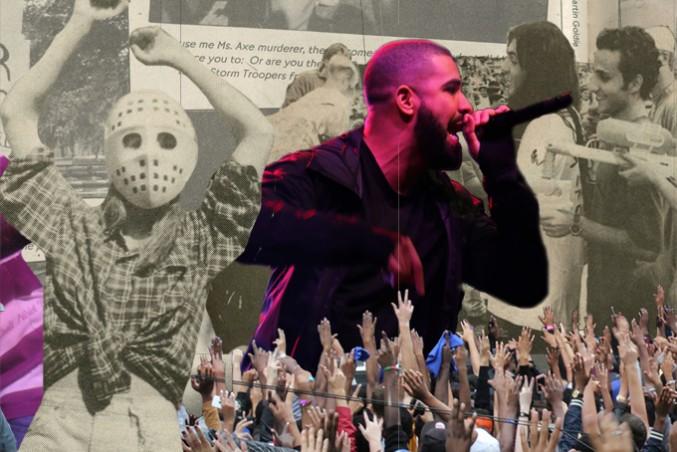Take a look with us at some significant events in Ryerson’s history!
Arts
In 1995, Canadian folk band Great Big Sea headlined the concert with beers in hand. Masked, grunge-esque students came out for the show.
In 2015, Toronto’s 6ix God Drake made an appearance alongside Future.

File photo
Biz & Tech
1985
In the mid-1980s, students interested in developing new technology could learn at Ryerson’s Centre for Advanced Technology Education (CATE), which focused on teaching people how to combine computers, robots and lasers with manufacturing.
The centre opened in 1985 in Eric Palin Hall, where two-floors worth of office and lab space had been added. A year later, a computer program called ELVIS was developed at the centre.
The EducationaL VISion system was designed to do quality inspection checks for industrial robots. ELVIS was the first robotic vision system in North America designed specifically for teaching, CATE’s director of marketing told The Toronto Star.
2016
Ryerson researchers continue to develop new technologies and acronyms for their organizations’ names.
In March, Federal Minister of Science Kirsty Duncan announced that the NSERC Energy Storage Technology (NEST) network, led by Ryerson researcher Bala Venkatesh, had received about $5 million to study energy storage technologies at Ryerson and 14 other universities.
Venkatesh told The Eyeopener the grant was the biggest ever received at Ryerson. Venkatesh is the director of Ryerson’s Centre for Urban Energy (CUE), which studies energy storage technologies such as batteries, pole-top storage units and microgrids.

Photo: Jan Becker
Communities
November 1994
Bisexuals, Gays and Lesbians of Ryerson (BAGLOR) received a ‘closet-sized’ office in Jorgenson Hall. Coordinators joked about how they were used to the closet, but would like to have a space large enough to conduct meetings and social gatherings. It took several years for BAGLOR (now RyePride) to be relocated.
February 2016
After a year of collecting data and meeting with campus groups, Ryerson created its first ever sexual violence policy. This was accompanied by the opening of the Office of Sexual Violence Support and Education, with Farrah Khan hired as the first coordinator.

Photo: Annie Arnone
Fun
October 1971
An Eyeopener office door was unhinged and hidden somewhere on campus after Ryerson security insisted it be locked past 11 p.m. This meant that people couldn’t get out to use the bathroom, and you can’t piss through a locked door. When security came back and asked the Eye’s staff about the seemingly mysterious disappearance, the editors pretended not to know what happened.
October 2015
Turns out people care a lot about toilet paper; two-ply, specifically. Last year, a major scandal plagued Ryerson —it was all over social media and even made national headlines. After a mysterious box of two-ply toilet paper was discovered on campus, people started to ask some questions. It turns out only Ryerson’s top dogs in their Jorgenson Hall ivory tower get the two-ply, while us lowly serfs are stuck with one-ply. It’s a pretty big deal.

File photo
News
January 2002
During the RyeSAC elections back in 2002, VP finance and services candidate Sajjad Wasti had ongoing problems with people defacing and destroying his posters. Over a two week period, he found his campaign materials plastered with the word “loser.”
The fourth-year business managment student said that he suspected his opposition may have been behind the act of vandalism.
When asked if he would join in on the dirty politics act, Wasti said, “Of course it crossed my mind, but I’m not going to do it.”
March 2016
During the 2016 RSU election, posters popped up around campus shaming the Impact slate for the Gilary Massa layoff.
Massa was laid off during her maternity leave due to financial restructuring within the RSU.
The posters referenced the “I stand with Gilary” Facebook page, which was created shortly after the restructuring happened. The word “shame” was written over the faces of the Impact candidates.
Obaid Ullah, former VP operations and now RSU president, filed a slander complaint as a result. The opposing slate later posted on Facebook saying that none of their members were involved.

Photo: Ryerson Archives
Sports
Jan. 29, 1964
One Wednesday night in January 1964, two RTA students made history in the Kerr Hall gymnasium. As the men’s basketball team suffered an 86-46 drubbing in an exhibition game against Waterloo, Paul Vickers did play-by-play while Bill Bird provided colour commentary for a live broadcast on Ryerson’s radio station, CJRT. It was the first live broadcast of a Ryerson sporting event on record, and made the Rams the first college basketball team in Canada to have live radio broadcasts of its games.
March 19, 2014
Fifty years after Paul Vickers and Bill Bird made history with their first live broadcast, Ryerson and the Rogers Sportsnet television network announced a deal that continues to reshape the university’s identity two years later. With a $750,000 investment from Sportsnet, Ryerson made official plans to open a state-of-the-art broadcasting studio at the MAC for the 2014 launch of the RTA Sport Media undergraduate program. The degree is one of the first and most specialized programs of its kind in North America. With its numerous student-run media outlets, an active media division within its athletics department and now the young RTA program, Ryerson is cementing its position as a hotbed for the future of Canadian sport media.











Leave a Reply